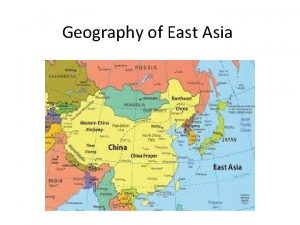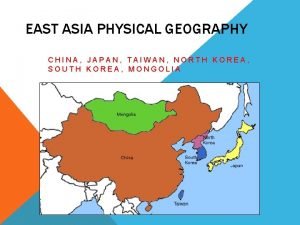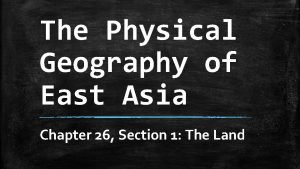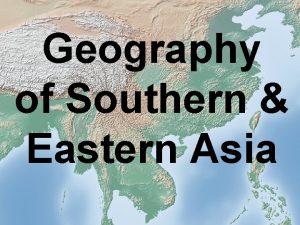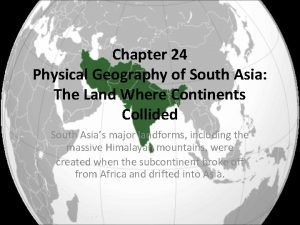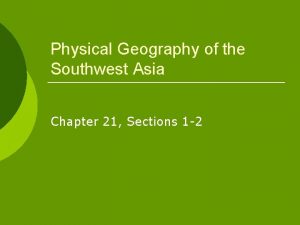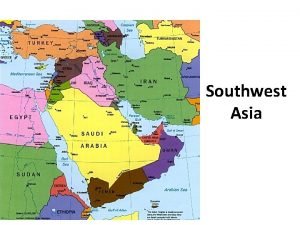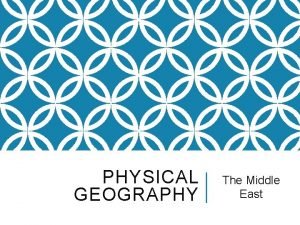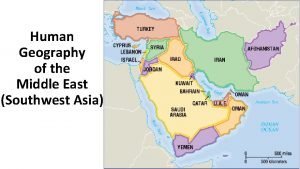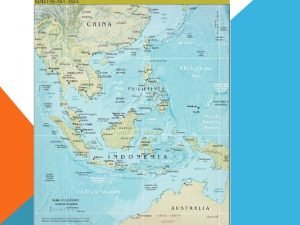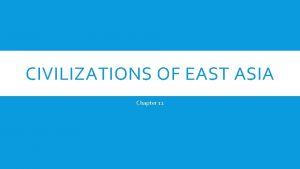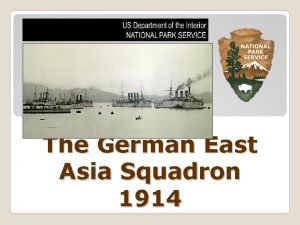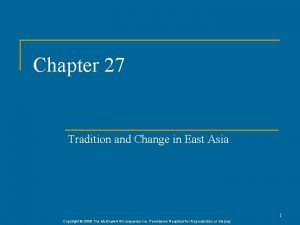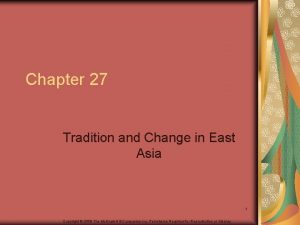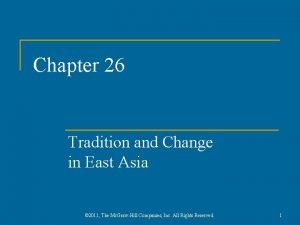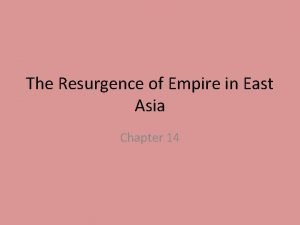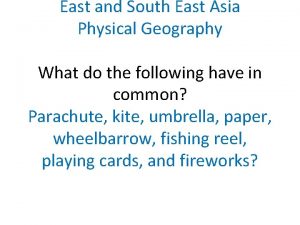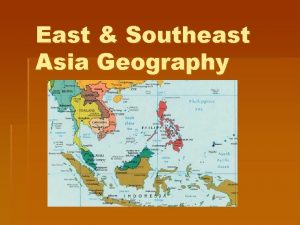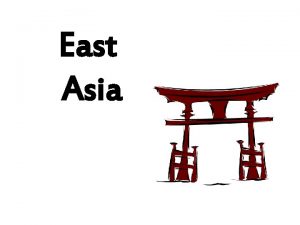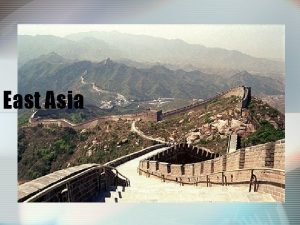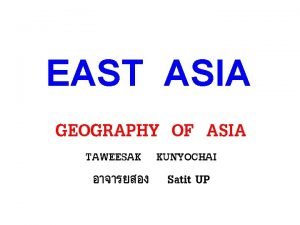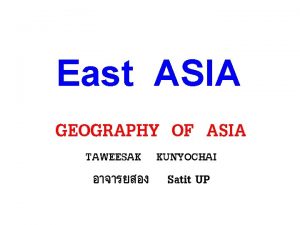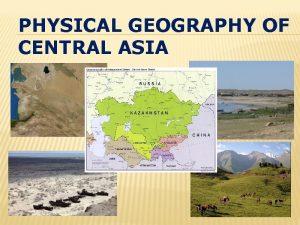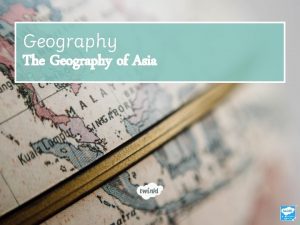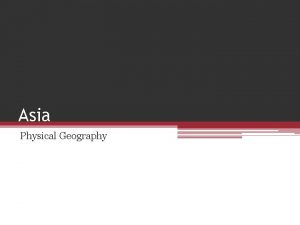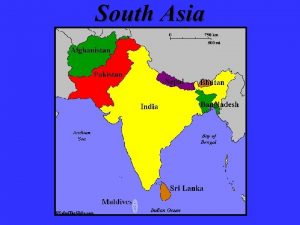Geography of East Asia Physical Geography The physical



















- Slides: 19

Geography of East Asia

Physical Geography • The physical geography is very distinct and diverse. • The major areas of the region are all set on different landforms. These areas include 1. China (Continental)- “mainland” or landlocked 2. Japan (insular)- an island 3. Korea (peninsular)- almost completely surrounded by water 4. Vietnam (peninsular/continental)- mix of landlocked and almost completely surrounded by water.


Physical Geography Continued • The physical makeup of East Asia has had a major impact on the history and development of each country. • The first settlers of China settled along major river systems such as the Yellow River and the Yangzi. • These settlements then moved South. • China is also dominated by mountains, steppes, plateaus, and deserts. • These areas were mostly settled by nomadic people who intruded on already settled land. • Japan is composed of four islands, which isolated them throughout history and hindered their development.


Major Landmarks/Areas • Great Wall of China • The wall is 5, 500 miles in length and consists of numerous walls and fortifications running parallel to one another. • The wall was the idea of Emperor Qin Shi Huang in the 3 rd Century BC as a way to prevent invasions of barbaric tribes into the Empire. • The wall was never successful at keeping invaders out, but became a symbol of Chinese strength and power.


Silk Road • The Silk Road was an ancient trade route between the East and West. It was established by the Han Dynasty in 206 BC. • Linked China to the Roman Empire • The road extended from Xian to the Mediterranean. • Aside from the goods that were traded on the road it also led to the mixing of cultures between China, India, Persia, Arabia, and Rome.


Mount Fuji • Located on the island of Japan about 60 miles southwest of Tokyo. • It is the highest peak in Japan. • It is a volcano that last erupted in 1707 - the largest eruption on record (for Fuji). • It deposited ash as far away as Tokyo. • It is a major symbol of Japan and the region and is the subject of many works of art.


Climate • Both similar to and different than that of the United States. • Similarity= temperate climate, meaning cold winters and warm summers. • Difference= The majority of the precipitation happens in the summer and not the winter. • This allows for intensive agriculture or the ability to grow a lot during a short time. • The climate makes rice the primary crop. Rice produces more per acre than other crops and can feed a higher population.


Population • China is the most populated country in the world with about 1. 3 billion people. • Due to the inability of the land to grow crops, only 7% of the land, you see small pockets with high populations. • The population of Japan is 127 million people- about ½ the population of America. However, Japan is about the size of California, so it is EXTREMELY crowded. • The most populated areas are: 1. China 2. Japan 3. Vietnam 4. South Korea 5. North Korea


Culture • The geography of East Asia has played a major role in the diverse culture of the region. • The earliest settlers settled in river valleys before expanding south, bringing their beliefs, language, and religion with them. • The geography has also prevented, and separated, cultures in the region. Examples are: o Japan: being an island they were often isolated from the mainland o Korea: completely divided not only by geography, but also through beliefs and ideas o Vietnam: Separated by mountains which led to opposing views on government, as well as culture.


Culture Continued • Most Spoken Languages: 1. Mandarin 2. Japanese 3. Vietnamese 4. Korean • Most Common Religious Beliefs” 1. Confucianism 2. Christianity 3. Buddhism 4. Islam

 Physical geography of east asia
Physical geography of east asia Physical geography east asia
Physical geography east asia Chapter 27 section 1 landforms and resources
Chapter 27 section 1 landforms and resources Physical geography of east asia
Physical geography of east asia Southern & eastern asia physical features map answer key
Southern & eastern asia physical features map answer key Lesson 1 physical geography of southeast asia
Lesson 1 physical geography of southeast asia Climate zones of asia
Climate zones of asia North africa and southwest asia physical geography
North africa and southwest asia physical geography Chapter 21 physical geography of southwest asia
Chapter 21 physical geography of southwest asia Chapter 21 physical geography of southwest asia
Chapter 21 physical geography of southwest asia Physical geography of middle east
Physical geography of middle east Is middle east in asia
Is middle east in asia What is oceania in 1984
What is oceania in 1984 Mon khmer
Mon khmer Lesson quiz 11-4 civilizations of east asia
Lesson quiz 11-4 civilizations of east asia German east asia squadron
German east asia squadron Chapter 27 tradition and change in east asia
Chapter 27 tradition and change in east asia Chapter 27 tradition and change in east asia
Chapter 27 tradition and change in east asia Chapter 26 tradition and change in east asia
Chapter 26 tradition and change in east asia Chapter 14 the resurgence of empire in east asia
Chapter 14 the resurgence of empire in east asia
